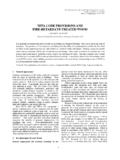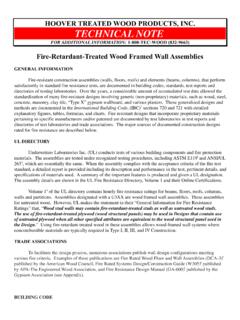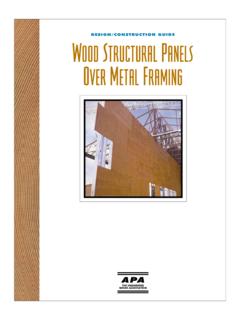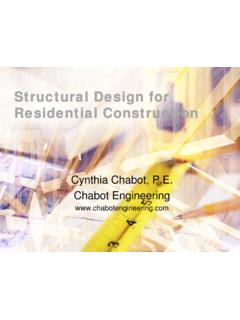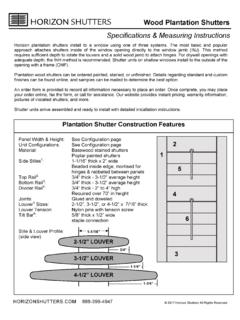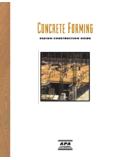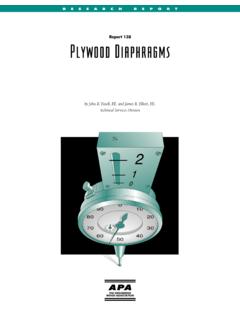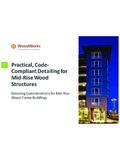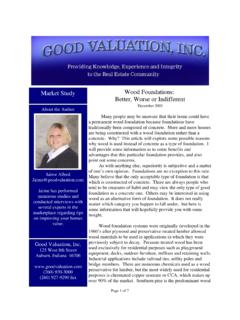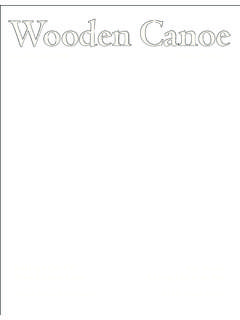Transcription of Wood use in Type I and II (noncombustible) construction
1 Wood use in Type I and II (noncombustible) BuecheHoover Treated Wood Products, Thomson, Georgia, USAABSTRACT: As with many products, the building code regulates the use of wood in construction . Two broadcategories separate materials: combustible and noncombustible. Codes limit the application of combustiblematerials on the basis of fire and life safety. The question then is, Are there options available in the 2009 International Building Code for using wood in structural applications in lieu of noncombustible materials? FireRetardant Treated Wood (FRTW) provides that option. The 2009 IBC recognize FRTW for many applicationswhere a noncombustible material is mandated. A few applications allow FRTW in lieu of 1-hour INTERNATIONAL BUILDING CODEIn 1994 the three existing national building code orga-nizations created the Internal Code Council (ICC),a nonprofit organization dedicated to developing asingle set of comprehensive and coordinated nationalmodel construction codes.
2 The goal of the ICC wasto have a family of national codes available by theyear 2000, and ICC met that goal. In 1996 workbegan on the creation of the International BuildingCode (IBC). It was developed primarily from theprovisions of the three nationally recognized modelbuilding codes: the National Building Code (NBC),Standard Building Code (SBC), and Uniform BuildingCode (UBC).The IBC is a comprehensive code and is the coordi-nating document for the suite of International certain instances, the IBC provisions are identicalto those of the three model codes. In other instances,the provisions are a modification of requirements fromone or more of the three regional codes. Some provi-sions are entirely new and unique to the FIRE SAFETYFire safety is the reduction of the potential for harmto life as a result of fire in buildings.
3 Although thepotential for being killed or injured in a fire cannotbe completely eliminated, fire safety in a building canbe achieved through proven building design featuresintended to minimize the risk of harm to people fromfire to the greatest extent a building to ensure minimal risk or tomeet a prescribed level of safety from fire is morecomplex than just the simple consideration of whatbuilding materials will be used in construction of thebuilding. Many factors must be considered includingthe use of the building, the number of occupants, howeasily they can exit the building in case of a fire andhow a fire can be IBC only regulates those elements which arepart of the building construction . The building con-tents found in any building are typically not regulatedby the IBC but in some cases are regulated by thefire codes.
4 The classification of buildings or parts ofbuildings according to their intended use accounts for: the quantity and type of combustible materials likelyto be present (potential fire load); the number of persons likely to be exposed to thethreat of fire; the area of the building; the height of the classification is the starting point in determin-ing which fire safety requirements apply to a particularbuilding. Classification dictates: the type of building construction ; the level of fire protection; materials that do not sustain fire do not guar-antee the safety of a structure. Steel, for instance,quickly loses its strength when heated and its yieldpoint decreases significantly as it absorbs heat, endan-gering the stability of the structure.
5 An unprotected,conventional steel joist system will fail in less than10 minutes under standard laboratory fire exposuretest methods, while a conventional wood joist floorsystem can last up to 15 reinforced concrete is not immune to concrete structures have rarely collapsed, con-crete will spall under elevated temperatures, expos-ing the steel reinforcement and weakening 2010 Taylor & Francis Group, London, UKIt is generally recognized then, that there is really nosuch thing as a fireproof building. Fires can occur inany type of structure. The severity of a fire, however,is contingent on the ability of a construction to: confine the fire; limit its effects on the supporting structure; control the spread of smoke and varying degrees, any type of construction canbe designed as a system, that is, a combination ofconstruction assemblies, to limit the effects of allows occupants sufficient time to escape thebuilding and for firefighters to safely reach the seat ofthe safety also depends on other parame-ters such as detection and exit paths, and the use ofautomatic fire suppression systems such as concepts form the basis of the FIRE RETARDANT TREATED WOODWood loses its strength in a different way than met-als.
6 In the early stages of a fire, wood s strength isincreased because of a reduction in moisture is a good insulator and does not transfer the heaton its surfaces to its core very quickly. While it may beburning or charring on its surface, its interior will berelatively cool for a long time. All this increases thelength of time wood and fire retardant treated woodwill retain its integrity time to get the people out ofthe building, time to get the firemen to the building,and time to extinguish the fire. Fire retardant treatedwood has the added advantage of maintaining struc-tural integrity even longer because it chars at a slowerrate than untreated wood is consumed. In addition, fireretardant treated wood will not spread the fire from oneportion of a building to another, and it will extinguishitself once the ignition source is is principally composed of cellulose, hemi-cellulose, and lignin, all of which change their phys-ical and chemical characteristics by oxidation andchemical decomposition.
7 This phenomenon is calledcombustion or burning. It destroys the structure of thewood so it will not support a load by reducing it toa small amount (1% or less) of a mineral substancecalled kindling temperature of wood (500 F) is thetemperature above which the wood will ignite sponta-neously. At this point, as a result of chemical decom-position, the wood contributes a heat of its own, andthe temperature rises even higher. Combustible gasesand smoke are given off, and the wood begins tochar. Because wood in itself is a good insulator, thehigh temperature at the surface is not readily trans-mitted to its interior. This insulating quality and themoisture always present in the wood results in a slowdestruction, especially of large timbers.
8 How quicklythe material burns, depends on its size, shape, the aircirculation, and the control of radiation. Therefore, ifthe conduction of heat in the wood can be controlled toprevent the temperature of the wood from exceedingits kindling temperature, its rate of destruction canbe greatly reduced. This is the key to Fire RetardantPressure Treated has shown that certain ingredients, whenadded to the wood, are able to insulate its surfaces sothat its temperature remains below the kindling tem-perature for an extended period of time no matter howhot the heat source might become. Among the ingredi-ents used for this purpose are the acid salts of sulfatesand phosphates, borates, and boric fire retardant treatments are water-soluble sowater is used as the vehicle for carrying the treatmentsinto the wood.
9 The only effective method of applica-tion is by the Pressure Treatment Process. After pres-sure impregnation, most of the moisture is removeduntil the treated wood has a moisture content of nomore than 19% for lumber and 15% for retardant treatments do not necessarily preventwood from being destroyed by fire, but they are thenecessary ingredient that, when added to wood, slowdown the decomposition to such an extent that thewood structurally out performs most other buildingmaterials during actual fire temperatures reach a point slightly below thekindling point, the chemicals react with each gases and water vapor are formed andreleased at a slow persistent rate which envelope thewood fibers insulating them from temperatures thatcause the wood to decompose.
10 The inflammable gasesandtarsarereducedandaninsulatingcha rformsonthesurface of the wood, further slowing down the processof of the greatly reduced rate of decomposi-tion or burning, the structural integrity of the wood ispreserved for a long period of time, smoke and toxicfumes are greatly reduced, and when the heat sourceis removed, the wood ceases to decompose and thespread of fire by the wood is Section , the IBC defines fire-retardant-treated wood as any wood product which, whenimpregnated with chemicals by a pressure processor other means during manufacture, shall have, whentested in accordance with ASTM E 84, a listed flamespread index of 25 or less and show no evidence ofsignificant progressive combustion when the test iscontinued for an additional 20-minute period.
